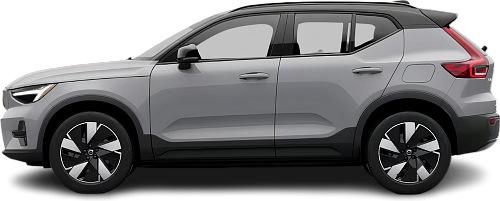USA EV Comparison: Volvo XC40 Recharge (EX40) Pure Electric vs Peugeot e-3008 98 kWh FWD
Struggling to Decide? Let AI Help!
Your AI Summary Is Ready!
General Info
While the Peugeot e-3008 98 kWh Long Range FWD (2024-…) is currently produced, it is not offered for sale in the United States. The Volvo XC40 Recharge (EX40) Pure Electric (2022) has been discontinued, it was never offered for sale in the United States.
The two vehicles share the same body style: SUV.
| Property | Volvo XC40 Recharge (EX40) Pure Electric | Peugeot e-3008 98 kWh FWD |
|---|---|---|
| Years of Production | 2022-2022 | 2024-… |
| Current Status | Discontinued | Produced |
| Country of Manufacture | Belgium | France |
| Body Style | SUV | SUV |
| Market Availability | EU | EU |
| GCC Score | 6.1 | 6.9 |
Range and Efficiency
The Peugeot e-3008 98 kWh Long Range FWD (2024-…) boasts a greater real-world range, a larger battery, and superior energy efficiency compared to the Volvo XC40 Recharge (EX40) Pure Electric (2022).
| Property | Volvo XC40 Recharge (EX40) Pure Electric | Peugeot e-3008 98 kWh FWD |
|---|---|---|
| Range (WLTP) | 264 mi | 435 mi |
| Range (GCC) | 227 mi | 370 mi |
| Battery Capacity (Nominal) | 69 kWh | 101 kWh |
| Battery Capacity (Usable) | 67 kWh | 96.9 kWh |
| Efficiency per 100 mi | 29.5 kWh/100 mi | 26.2 kWh/100 mi |
| Efficiency per kWh | 3.39 mi/kWh | 3.82 mi/kWh |
| Range and Efficiency Score | 6.2 | 9.4 |
Charging
Both vehicles utilize a standard 400-volt architecture.
The Peugeot e-3008 98 kWh Long Range FWD (2024-…) offers faster charging speeds at DC stations, reaching up to 160 kW, while the Volvo XC40 Recharge (EX40) Pure Electric (2022) maxes out at 150 kW.
Both vehicles are equipped with the same on-board charger, supporting a maximum AC charging power of 11 kW.
| Property | Volvo XC40 Recharge (EX40) Pure Electric | Peugeot e-3008 98 kWh FWD |
|---|---|---|
| Max Charging Power (AC) | 11 kW | 11 kW |
| Max Charging Power (DC) | 150 kW | 160 kW |
| Architecture | 400 V | 400 V |
| Charge Port | CCS Type 2 | CCS Type 2 |
| Charging Score | 6.1 | 6.9 |
Performance
Both vehicles are front-wheel drive.
Both cars offer the same motor power, but the Volvo XC40 Recharge (EX40) Pure Electric (2022) achieves a faster 0-60 mph time.
| Property | Volvo XC40 Recharge (EX40) Pure Electric | Peugeot e-3008 98 kWh FWD |
|---|---|---|
| Drive Type | FWD | FWD |
| Motor Type | PMSM | PMSM |
| Motor Power (kW) | 170 kW | 170 kW |
| Motor Power (hp) | 228 hp | 228 hp |
| Motor Torque | 243 lb-ft | 253 lb-ft |
| 0-60 mph | 7.1 s | 8.6 s |
| Top Speed | 99 mph | 106 mph |
| Performance Score | 3.6 | 3.6 |
Dimensions
The Peugeot e-3008 98 kWh Long Range FWD (2024-…) is longer, but has a similar width and height to the Volvo XC40 Recharge (EX40) Pure Electric (2022).
Both models have similar wheelbase lengths.
| Property | Volvo XC40 Recharge (EX40) Pure Electric | Peugeot e-3008 98 kWh FWD |
|---|---|---|
| Length | 174.2 in | 178.7 in |
| Width (with Mirrors) | 80.1 in | 74.6 in |
| Width (w/o Mirrors) | 73.7 in | 74.4 in |
| Height | 65 in | 64.6 in |
| Wheelbase | 106.4 in | 107.8 in |
Cargo and Towing
The Peugeot e-3008 98 kWh Long Range FWD (2024-…) features a larger trunk, but the Volvo XC40 Recharge (EX40) Pure Electric (2022) offers greater maximum cargo capacity when the rear seats are folded.
A frunk (front trunk) is available in the Volvo XC40 Recharge (EX40) Pure Electric (2022), but the Peugeot e-3008 98 kWh Long Range FWD (2024-…) doesn’t have one.
The Volvo XC40 Recharge (EX40) Pure Electric (2022) has a towing capacity of up to 2000 lb, whereas the Peugeot e-3008 98 kWh Long Range FWD (2024-…) is not officially rated for towing in the US.
| Property | Volvo XC40 Recharge (EX40) Pure Electric | Peugeot e-3008 98 kWh FWD |
|---|---|---|
| Number of Seats | 5 | 5 |
| Curb Weight | 4475 lb | 4960 lb |
| Cargo Volume (Trunk) | 16 ft3 | 18.4 ft3 |
| Cargo Volume (Max) | 57.5 ft3 | 52.3 ft3 |
| Cargo Volume (Frunk) | 1.1 ft3 | - Cargo Volume (Frunk) |
| Towing Capacity | 2000 lb | - Towing Capacity |
| Cargo and Towing Score | 6.7 | 6.3 |




